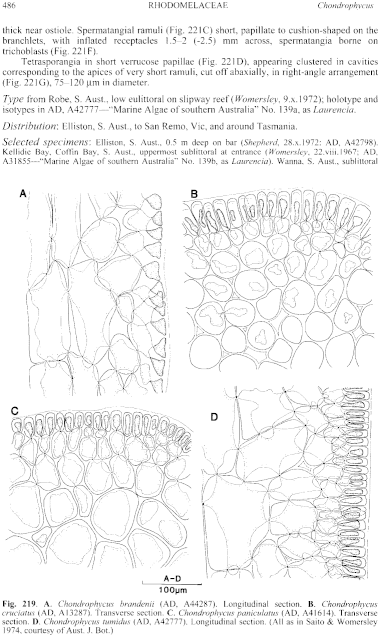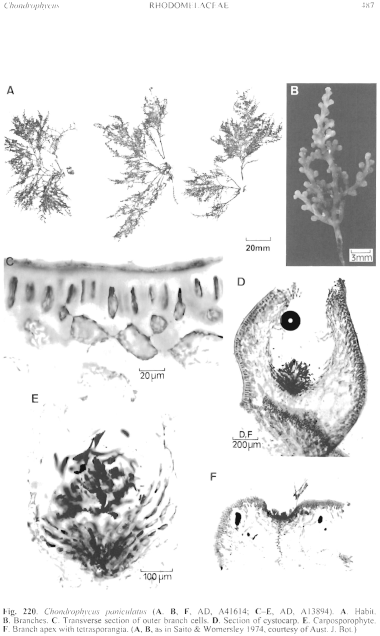|
|
|
|
|
|||||||||||
|
Electronic Flora of South Australia Species Fact Sheet
Phylum Rhodophyta – Family Rhodomelaceae – Tribe Laurencieae
Synonyms
Chondria obtusa var. paniculata C. Agardh 1822: 343.
Laurencia paniculata (C. Agardh) J. Agardh 1852: 755; 1876: 651. De Toni 1903: 788. Falkenberg 1901: 247. Saito 1969: 158. Saito & Womersley 1974: 845, figs 5D, 25. Shepherd & Womersley 1976: 191; 1981: 368. Yamada 1931: 192, pl. 3a.
Thallus (Fig. 220A) dark red-brown, rigid, cartilaginous, 8–12 cm high, pyramidal in outline, becoming denuded below, profusely and closely radially branched (Fig. 220B) for 3–5 orders, branches terete; axes 1–1.5 mm in diameter, decreasing to branchlets 0.5–0.8 (–1) mm in diameter and 1–3 mm long, apices truncated and often slightly verrucose just below. Holdfast discoid, 2–10 mm across; epilithic. Structure. Epidermal cells polygonal, (12–) 15–25 (–35) µm across and L/D 1 (–2) near apices, scarcely elongating below, without secondary pit-connections or corps en cerise; in section, epidermal cells compact and palisade-like (Figs 219C, 220C), L/D (1–) 1.5–2 near apices, 2–3 (–4) in older branches; cortical cells compact, with few spaces and without lenticular thickenings. Cells with discoid to elongate rhodoplasts, ribbon-like and reticulate in cortical cells.
Reproduction: Gametophytes dioecious. Procarps not observed. Carposporophytes (Fig. 220E) with a basal fusion cell and branched gonimoblast bearing clavate terminal carposporangia. Cystocarps (Fig. 220D) sessile, conical and broad-based, 0.7–1 mm in diameter; pericarp ostiolate and slightly operculate, 6–8 cells thick. Spermatangial ramuli short, with broad, truncated to concave receptacles 0.7–1.2 mm across, spermatangia borne on trichoblasts.
Tetrasporangial branchlets short, swollen, simple or basally branched, 800–1100 µm in diameter and 0.5–1.5 mm long, with tetrasporangia (Fig. 220F) cut off abaxially in right-angle arrangement, ovoid, 60–110 µm in diameter, tetrahedrally or decussately divided.
Type from Trieste, Adriatic Sea; lectotype in Herb. Agardh, LD, 36711.
Selected specimens: Head of Great Australian Bight, S. Aust., upper sublittoral (Womersley, 4.ii.1954; AD, A19150). Scott Bay, S. Aust., upper sublittoral pool (Womersley, 27.i.1951; AD, A13894). Elliston, S. Aust., upper sublittoral, reef in bay (Womersley, 15.i.1951; AD, A13733). Aldinga, S. Aust.; just below low tide (Saito, 27.ii.1972; AD, A41935). Vivonne Bay, Kangaroo I., S. Aust., in large pool, S side Ellen Point (Womersley, 2.1.1 949; AD, A10810). Robe, S. Aust., 1–2 m deep near jetty (Saito, 12.ii.1972; AD, A41614). Crawfish Rock, Westernport Bay, Vic., at low tide level (Women ley, 16.i.1974; AD, A44608-"Marine Algae of southern Australia" No. 165).
Distribution: Widespread in the tropics and Mediterranean.
In southern Australia, from the Head of the Great Australian Bight, S. Aust., to Western Port, Victoria.
Taxonomic notes: Chondrophycus paniculatus apparently occurs in scattered localities in southern Australia, usually just below low tide level.
References:
AGARDH, C.A. (1822). Species Algarum. Vol. 1, Pt 2, pp. 169–398. (Berling: Lund.)
AGARDH, J.G. (1852). Species Genera et Ordines Algarum. Vol. 2, Part 2, pp. 337–720. (Gleerup: Lund.)
AGARDH, J.G. (1876). Species Genera et Ordines Algarum. Vol. 3, Part 1 - Epicrisis systematis Floridearum, pp. i-vii, 1–724. (Weigel: Leipzig.)
BOISSET, F., FURNARI, G., CORMACI, M. & SERIO, D. (2000). The distinction between Chondrophycus patentirameus and C. paniculatus (Ceramiales, Rhodophyta). Eu. J. Phycol. 35, 387–395.
DE TONI, G.B. (1903). Sylloge Algarum omnium hucusque Cognitarum. Vol. 4. Florideae. Sect. 3. pp. 775–1521 + 1523–1525. (Padua.)
FALKENBERG, P. (1901). Die Rhodomelaceen des Golfes von Neapel und der angrenzenden Meeres-abschnitte. Fauna und Flora des Golfes von Neapel. Monogr. 26. (Friedländer: Berlin.)
SAITO, Y. & WOMERSLEY, H.B.S. (1974). The southern Australian species of Laurencia (Ceramiales: Rhodophyta). Aust. J. Bot. 22, 815–874.
SAITO, Y. (1969). The algal genus Laurencia from the Hawaiian Islands, the Philippine Islands and adjacent areas. Pacif. Sci. 23, 148–160.
SHEPHERD, S.A. & WOMERSLEY, H.B.S. (1976). The subtidal algal and seagrass ecology of St Francis Island, South Australia. Trans. R. Soc. S. Aust. 100, 177–191.
SHEPHERD, S.A. & WOMERSLEY, H.B.S. (1981). The algal and seagrass ecology of Waterloo Bay, South Australia. Aquat. Bot. 11, 305–371.
YAMADA, Y. (1931). Notes on Laurencia, with special reference to the Japanese species. Univ. Calif Pubis Bot. 16, 185–311.
The Marine Benthic Flora of Southern Australia Part IIID complete list of references.
Publication:
Womersley, H.B.S. (24 February, 2003)
The Marine Benthic Flora of Southern Australia
Rhodophyta. Part IIID. Ceramiales – Delesseriaceae, Sarcomeniaceae, Rhodomelaceae
Reproduced with permission from The Marine Benthic Flora of Southern Australia Part IIID 2003, by H.B.S. Womersley. Australian Biological Resources Study, Canberra. Copyright Commonwealth of Australia.
Illustrations in Womersley Part IIIA, 2003: FIGS 219C, 220.

Figure 219 enlarge
Fig. 219. A. Chondrophycus brandenii (AD, A44287). Longitudinal section. B. Chondrophycus cruciatus (AD, A13287). Transverse section. C. Chondrophycus paniculatus (AD, A41614). Transverse section. D. Chondrophycus tumidus (AD, A42777). Longitudinal section. (All as in Saito & Womersley 1974, courtesy of Aust. J. Bot.)

Figure 220 enlarge
Fig. 220. Chondrophycus paniculatus (A, B, F, AD, A41614; C–E, AD, A13894). A. Habit. B. Branches. C. Transverse section of outer branch cells. D. Section of cystocarp. E. Carposporophyte. F. Branch apex with tetrasporangia. (A, B, as in Saito & Womersley 1974, courtesy of Aust. J. Bot.)

|
Email Contact: State Herbarium of South Australia |

|